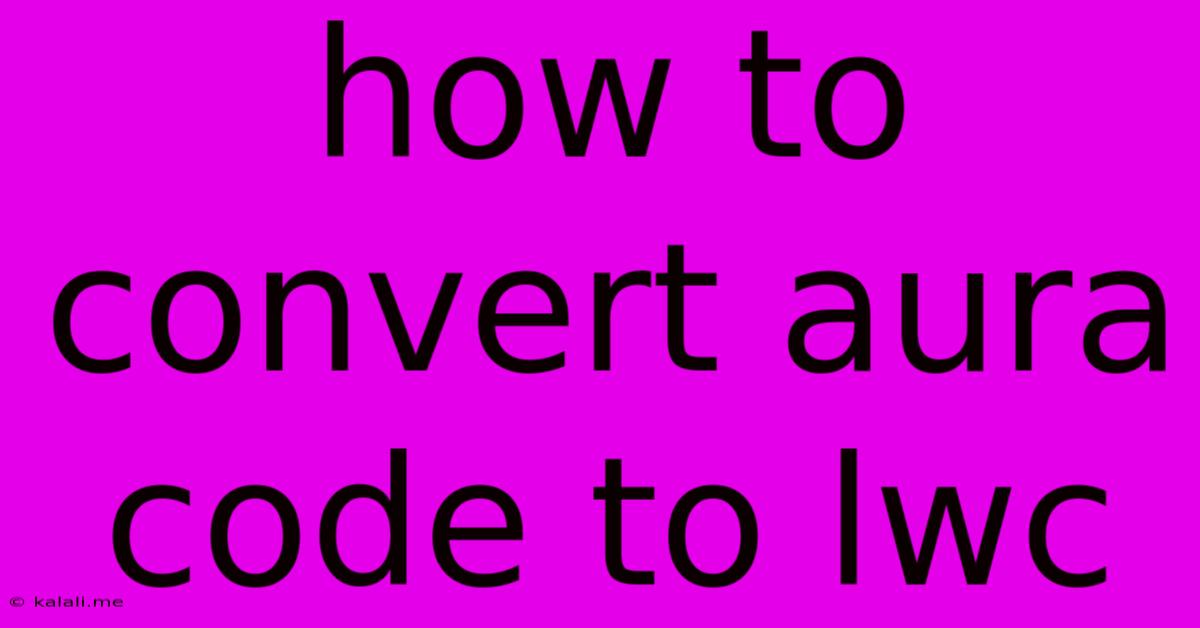How To Convert Aura Code To Lwc
Kalali
May 23, 2025 · 4 min read

Table of Contents
How to Convert Aura Code to LWC: A Comprehensive Guide
Meta Description: Learn how to smoothly transition your Aura components to the modern Lightning Web Components (LWC) framework. This guide covers key conversion strategies, common challenges, and best practices for a successful migration.
Migrating from Aura components to Lightning Web Components (LWC) can seem daunting, but with a structured approach, it's a manageable process that offers significant benefits. LWC offers a more modern, performant, and developer-friendly experience compared to Aura. This guide will walk you through the key steps and considerations involved in converting your Aura code to LWC.
Understanding the Differences: Aura vs. LWC
Before diving into the conversion process, it's crucial to understand the fundamental differences between Aura and LWC. This understanding will inform your conversion strategy and help you anticipate potential challenges.
- Component Model: Aura utilizes a proprietary component model, while LWC leverages standard web components, offering better interoperability and leveraging familiar web standards like HTML, CSS, and JavaScript.
- Framework: Aura is a server-side framework, while LWC is a client-side framework, resulting in improved performance and a more responsive user experience.
- Data Handling: Aura uses server-side controllers and event handling, whereas LWC uses JavaScript for data manipulation and event management, enabling more efficient client-side processing.
- Templating: Aura utilizes a custom templating language, while LWC uses standard HTML templates, leading to easier maintenance and familiarity for front-end developers.
Step-by-Step Conversion Process
The conversion process isn't a one-size-fits-all solution. The complexity of your Aura component will determine the required effort. However, a general approach involves these key steps:
-
Analyze Your Aura Component: Begin by thoroughly analyzing the functionality and dependencies of your Aura component. Identify its core features, data interactions, and external dependencies. Document these aspects to guide the conversion process.
-
Identify LWC Equivalents: For each Aura component, identify the equivalent LWC features and functionalities. This includes mapping Aura attributes, events, and methods to their LWC counterparts. This involves understanding the differences in how data is handled and events are triggered.
-
Convert the Template: Translate the Aura template markup to standard HTML within the LWC template file. Replace Aura-specific attributes and expressions with standard HTML attributes and JavaScript expressions.
-
Convert the Controller Logic: Migrate the Aura controller logic to JavaScript within the LWC JavaScript file. This involves rewriting the server-side logic to use client-side JavaScript for data handling, event management, and interactions with external services. Consider using appropriate JavaScript frameworks or libraries to manage complex logic effectively.
-
Handle Data Handling and Events: Carefully manage data flow and event handling. Translate Aura's event handling mechanisms to LWC's standard event system, leveraging JavaScript's event listeners and custom events.
-
Address Component Dependencies: If your Aura component relies on other Aura components or external libraries, you'll need to convert or replace these dependencies with their LWC equivalents or find suitable alternatives. This might involve creating new LWC components to replace existing Aura components.
-
Testing and Iteration: Thoroughly test your converted LWC component to ensure it functions as expected. Iterate on your conversion, addressing any issues or discrepancies that arise during testing. Employ automated testing to catch bugs early.
Common Challenges and Best Practices
-
State Management: Careful planning is needed to manage component state effectively in LWC. Consider using reactive properties and change detection mechanisms to ensure data consistency.
-
Data Handling: Translate server interactions carefully, focusing on asynchronous operations and proper error handling.
-
Testing: Implementing comprehensive unit and integration tests is crucial during and after the conversion process.
-
Modularization: Break down large Aura components into smaller, more manageable LWC modules for improved maintainability and reusability. Aim for high code cohesion and low coupling between components.
-
Documentation: Maintain clear and comprehensive documentation throughout the conversion process to track changes and ensure consistent understanding.
Conclusion
Converting Aura components to LWC presents a valuable opportunity to modernize your Salesforce applications and enjoy the benefits of a more efficient, performant, and developer-friendly framework. By following a structured approach, understanding the key differences between the two frameworks, and addressing common challenges proactively, you can successfully transition your Aura components to LWC and reap the rewards of a modern development experience. Remember to thoroughly test and iterate throughout the process to ensure a smooth and successful migration.
Latest Posts
Latest Posts
-
Salesforce Flow Decision For Only The Record Is Created Alias
May 23, 2025
-
Is Sherry Vinegar The Same As Sherry Cooking Wine
May 23, 2025
-
How To Show Two Primary Buttons Ui
May 23, 2025
-
Absolute Continuity But Not Bounded Variation
May 23, 2025
-
Natlib Limit On Number Of Authors
May 23, 2025
Related Post
Thank you for visiting our website which covers about How To Convert Aura Code To Lwc . We hope the information provided has been useful to you. Feel free to contact us if you have any questions or need further assistance. See you next time and don't miss to bookmark.